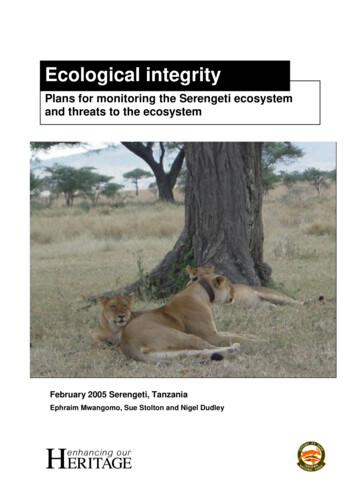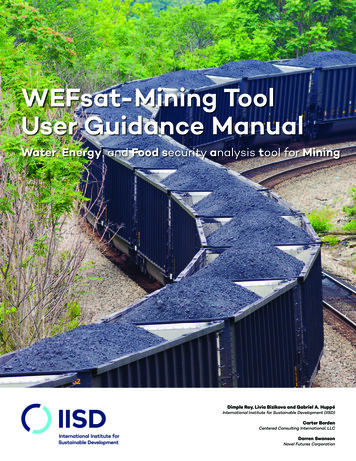
Transcription
Ecological integrityPlans for monitoring the Serengeti ecosystemand threats to the ecosystemFebruary 2005 Serengeti, TanzaniaEphraim Mwangomo, Sue Stolton and Nigel Dudley
Plan for Monitoring the Serengeti Ecosystem andThreats to the EcosystemThis document includes: an overview of the development of the monitoring plan (pages 2 - 5) a summary and frequency of all monitoring activities (page 6) a more detailed analysis of the indicators being monitored (pages 7 - 23)Introduction to monitoring planIn order to assess the outcomes of management of a site – i.e. whether management isactually protecting the unique values for which the site was designated – a monitoringprogramme is needed. The art of developing a good monitoring system is to select a fewindicators that capture as much information as possible about different aspects ofbiodiversity and ecosystem functioning, without costing an unrealistic amount or taking toomuch time to monitor.The plan being developed in the attached document is intended to monitor the ecologicalintegrity or biodiversity health of the Serengeti Ecosystem. Ecological integrity is definedby Parks Canada as being “the state of ecosystem development that is characteristic for itsgeographic location, has a full range of native species and supporting processes and is viable,i.e. is likely to persist”. We use this definition here.Conservation TargetsThe plan is based on monitoring eight Conservation Targets which have been selected torepresent and encapsulate the unique biodiversity of the Serengeti Ecosystem. Indicatorshave been chosen to monitor both the Key Ecological Attributes (KEA) of the system and themost serious threats facing the system. This approach has been developed from The NatureConservancy Enhanced 5-S framework – which is summarised below:Identify focal biodiversity to be the focus of planning and represent all biodiversity Identify Key Ecological Attributes (KEAs) for focal biodiversity (factors that characteriseand limit distribution including attributes of biological composition, spatial structure, bioticinteractions, environmental regimes and connectivity plus size, condition and landscapecontext) Identify indicators for KEAs (that need to be maintained if biodiversity is to be conserved)– these should reflect target health, be recognised by stakeholders, reflect threats, provideearly warning, and be cost effective and relatively easy to measure Rate the indicator status (for instance the natural range of variation to identify anddistinguish anthropogenic variation) Integrate rating to determine status of key ecological attributes, specific elements ofbiodiversity, integrity of entire protected area of landscape2
The KEAs and threat assessment for the Serengeti Ecosystem have been developed as partof the process to develop the new General Management Plan for the Serengeti National Park(GMPSNP) which will guide management activities from 2005 to 2015. The eight ConservationTargets are:1. The Migration2. The Mara River3. Riverine Forest4. Acacia Woodland5. Terminalia Woodland6. Kopje Habitat7. Black Rhinos8. Wild DogsIt should be noted that the last two Conservation Targets (black rhinos and wild dogs) arerestoration targets as black rhino numbers have dropped to only 40 animals in the SerengetiEcosystem from a population of around a thousand in 1975, primarily due to poaching, andalthough wild dogs are present in the Serengeti ecosystem there are no longer any individualsin the Serengeti National Park.Developing the PlanThe flow chart overleaf summarises the process undertaken to develop the indicators beingmonitored by this plan. The first step was undertaken as part of the GMPSNP process, theremaining steps have been developed by SENAPA Ecological Monitoring and the UNESCOEnhancing our Heritage project.The Enhancing our Heritage project has drawn on global expertise to develop its frameworkfor monitoring and assessing biodiversity (e.g. Parks Canada, Kruger National Park, TheNature Conservancy, the Wildlife Institute of India, WWF, University of Queensland). Fromthis work some underlying principals for ensuring monitoring is effect, provides informationfor adaptive management and can be easily reported have been suggested.The core issues to be measured should included: Biodiversity: species richness, population dynamics and tropic structure Ecosystem functions: succession or retrogression, vegetation age-class distributions,productivity, decomposition and nutrient retention Stressors: human land-use patterns, habitat fragmentation, pollutants, climate and parkspecific issuesThree key challenges face those undertaking biodiversity monitoring: Unrealistic assumptions about data: in many cases, very little is known, but it is notrealistic to monitor everything and fill all the data gaps Measuring the wrong things: the focus tends to be on large species, which are often veryadaptable, and thus do not necessarily reflect other changes in the ecosystem Confusion of outputs and outcomes: many systems still make simplistic links betweenoutputs (e.g. number of protected areas or management actions) and biodiversity health3
Steps taken to develop a Monitoring Plan for the Serengeti EcosystemStep 1: Set the management objectives and targetsStep 2: Make an initial choice of measures / indicators toreflect the management objectivesStep 3: Refine this draft list of indicators and determinetheir thresholds and power to detect changeNote: althoughthe arrowssuggest asequence,several ofthese stageswill usually takeplacesimultaneouslyOptional step 3a: identify responses to a breach of the thresholdsStep 4: Finalise indicatorsStep 5: Compare data needed with existingmonitoring processes / data and identify gapsStep 6: Develop detailed monitoring protocolsStep 7: Develop a data management systemStep 8: Assessment of management outcomes (initially toestablish a baseline and then to monitor against this baseline)4
Indicators of status and threatsThe following indicators have provisionally been agreed to monitor status and threats inSerengetiStatus indicatorsConservation target 1: The migrationConservation Target 2: The Mara RiverConservation target 3: Riverine forestConservation target 4: Acacia woodlandConservation target 5: Terminalia forestsConservation target 6: Kopje habitatConservation target 7: Black rhinoConservation target 8: wild dog Traditional migratory routesPopulation size of key speciesProductivity / recruitmentForage quality/spatial availabilityWater flow rateWater qualityForest habitatsForest area and coverIndicator speciesDensity of key tree speciesHerbivores in woodlandsDensity of TerminaliaHerbivores in woodlandsMain kopje plant speciesMain animal speciesSuitable y Decline in Mara River flow ratePoachingCutting of migration routesEarly dry season firesCultivation (Masawa, Lake Victoria)DiseaseFencing (creating hard boundary)Bore holes (NCA)PollutionBank erosionFireFireFireFirePoachingUnviable population sizeIn-breedingHuman disturbanceAvailability of secure habitatsUnviable population sizeInbreedingHuman-wild dogs conflictThreats indicatorsConservation target 1: The migrationConservation target 2: The Mara RiverConservation target 3:Conservation target 4:Conservation target 5:Conservation target 6:Conservation target 7:Riverine forestAcacia woodlandTerminalia woodlandKopje habitatBlack rhinoConservation target 8: Wild dog5
Summary and frequency of monitoring activitiesThe agreed monitoring activities are summarised below in order of the frequency with whichthey need to be undertakenActivityIndicator MonitoredFrequency Fire patterns and extent of dryseason firesFire managementplan ?2. Blood and tissuesampling3. Questioningapprehendedpoachers4. Water pressure,temperature5. Field recording Mortality of key speciesOpportunistic Opportunistic6. Rangerobservations7. Data collection8. Flow rate,dissolved oxygen,pH, salinity,visibility9. Census data,village recordsand satellite data10. Boundary survey11. Ground surveys Continuing increase in poachingIncrease in poaching mortality (BlackRhino)Minimum flow ratesWater Quality (Mara River)Population size (Black Rhino)Rhino sex ratio and proportion ofyoungNumber of visitors in the RhinoConservation areaRainfall patterns and trendsWater quality (Mara River) Continuing population pressure andextent of cultivation near migratoryroutesIntact park boundaryNumber of bore holes in NCA12. Aerial surveys Seasonal migratory movements Population size of large ungulates Resident ungulate species (in Acaciaand Terminalia woodland)13. Transects Two years14. Ground counts/transects15. Ground counts/transects Recruitment of key species (ratio ofjuveniles to adults)Oribi density (inTerminalia woodland) Population size of key carnivores(except lions)Five years16. Photo IDs andcall back17. Trail plots Population size of lionsFive years Five years18. Vegetationsurveys19. ? Forest extent/size and cover (andwidth of Mara River)Monitor selected sites (KopjeHabitat)Wild dog numbersWild dog recruitmentIncidence of human - wild dogconflict1.Satellite andground survey? Automatically every30 minutesDailyDaily whenmigration in areasDaily and monthlyMonthlyAnnuallyAnnuallyAnnually?Two yearsThree yearsFive yearsTo be determined6
A monitoring planIn the following set of tables, the indicators are discussed in detail. Information is given on aten different issues:1. Indicator: a simple description of the indicator2. Target: which one of the eight targets the indicator relates to3. Value being measured: either the key ecological attribute in the case of indicators ofstatus or a threat to attaining the target in the case of indicators of pressure Key ecological attribute: structure, composition, interactions and abiotic and bioticprocesses that enable the target to persist through their influence on the target’ssize, condition and landscape context Threats: the identified threat to the target4. Justification for selection: reasons why a particular indicator has been chosen5. Minimum integrity thresholds: the level at which the indicator gives cause for concern.This can sometimes have both an upper or lower limit (e.g. the minimum and maximumsizes that an animal species can reach before it causes serious concerns). In time andwith more research such thresholds should have numerical values; at the moment mostfor Serengeti are based on trends.6. Confidence level of threshold: an indication of how much confidence we have that thethreshold is accurate7. Monitoring activity: what needs to take place to collect information about the indicator8. Monitoring details (status, protocols, responsibilities): how information should becollected (methodology, timing, who is responsible etc), the status of informationcollection at the moment etc. This is an important section, which should give enoughinformation so that if staff change the way in which data are collected remains the sameand therefore indicators are comparable over time. More details on developing monitoringprotocols are given overleaf.9. Cost and funding sources: details of how much monitoring costs and where the fundingcomes from; this should also give some details about the security of funding10. Management options: what to do if the threshold is breached; i.e. a set of predeterminedmanagement responses so that action can be taken quickly there is a problem.7
Monitoring protocolsMonitoring protocols help ensure quality and credibility, so that monitoring is carried outconsistently, data are suitable for comparative analysis, and any changes detected are realand not due to differences in sampling, for instance if staff change. Monitoring protocolsshould be reviewed and tested, and provision for review and revision built into the protocol.Some suggestions as to the sort of information which can be included in protocols are givenbelow:Protocol Design Method: Method or methods used (e.g. sampling, interviews, observation, line transecttechniques, traps or strip census methodology) Procedures: Standardised procedures for collecting data, including, area of monitoring,staffing requirements (e.g. numbers, required training, time allocated), equipmentrequirements (e.g. vehicles, binoculars, GIS, traps) and safety procedures Frequency of data collection: i.e. monthly, quarterly, annually etc Data collection: Indicators to be measured (e.g. species, numbers of sightings, firefrequency, average earnings of local communities) Data analysis: advice regarding analysis and comparison (e.g. use of graphs, analysissoftware, comparisons etc) Data management: Records should include not only the monitoring results (data sets) butalso the history of monitoring development and revisionProtocal Adaptation Review: As with all management activities undertaken in a World Heritage site, monitoringactivities should be regularly reviewed to ensure that not only are the right things beingmonitored, but that this monitoring is being carried out in the most effective way Revision: Although protocols aim to ensure standardisation of monitoring (for the reasonsdiscussed above) protocols should also adapted and revised if the review processindicates this need. Revision may need to take place due to changes in technology, gaps indata need, budget changes, changing conditions on the ground including new pressures,etc.Additional information on monitoring protocols:– Guidelines for long-term monitoring protocols, printed in the Wildlife SocietyBulletin 2003 31(4) 1000-1003. otocolGuidelines.pdf– Environment Canada’s Ecological Monitoring and Assessment Network protocols on:Biodiversity Monitoring; Ecosystem Monitoring and Community-based Monitoring.See: www.eman-rese.ca/eman/– US National Parks Service Inventory and Monitoring m)8
Indicator: Seasonal migratory movements (in the west of the Grumeti River (Ikona WMA); East Kuka/West Loliondo route to Kenya; SalaiPlains, Lake Victoria; Maswa, Grumeti and Ikorongo GR)Target: The Migration Key Ecological Attributes: Traditional migratory routesJustification for selection: Threats to the ecosystem which support the migration route, especially in the areas outlined aboveMinimumintegritythresholdsConfidencelevel ofthresholdIf there is abreakdown oftraditionalmigratory routesHighMonitoring activityMonitoring details (status,protocols, responsibilities etc)Cost andfundingsourceCurrent: Rangerreports daily andanti-poaching patrolthat followsmigrationNeed system to systemise andanalyse information into GISsystemSNP, FZSCurrent: WildebeestCollarsInformation from eight collarshas been collected over the last# years but seven collars are nolonger in operation.US 4,000per collar(suggest that this isprobably not a costeffective method ofmonitoring migratoryroutes)New: Mappingmigratory routesthrough aerial g the protectionstatus for areas covered bythe migration outside of thePark.For this type of monitoring to beeffective some 40 collars wouldneed to be operating.Monthly surveys during timeswhen migration is outside ParkboundarySNP, FZS,TAWIRI(affordableand staffhave skillsneeded)9
Indicator: Population size of large ungulatesTarget: The Migration Key Ecological Attributes: Population size of key speciesJustification for selection: To monitor the long-term trend in populations and the causes of fluctuations (e.g. poaching and disease) that arenot expected from natural processes such as drought. Results of monitoring are also used by the Wildlife Division to grant hunting permits(see also indicator on vel ofthresholdMajor ng details (status,protocols, responsibilities etc)Current: Aerialsurveys andphotographs Surveys every two years ofmigration Carried out by TAWIRI CIMU (SNP, WD, NCAA,FZS)Cost and fundingsourceManagement optionsTANAPA/NCA/WD andFZS own the aircraft.TANAPA provide staff.FZS provide fuel andallowances for staff.Check census data forspecies under concern.Look for causes (i.e.disease/poaching) andany remedial actions.Decline in any speciesthat raises concern cantrigger follow upsurvey in following yearto verify trends.10
Indicator: Population size of key carnivores except lionsTarget: The Migration Key Ecological Attributes: Population size of key speciesJustification for selection: Healthy populations of carnivores reflect a healthy migratory system.MinimumintegritythresholdsConfidencelevel ofthresholdMajor unexplained HighfluctuationsMonitoring activityMonitoring details (status,protocols, responsibilities etc)Cost andfundingsourceManagement optionsFirst check data and then lookfor sources of change –probably diseaseCurrent: Ground transects (open plainsonly)Every five years carried outby Tanzania Carnivore CentreTanzaniaCarnivoreCentreCurrent: Visitorsighting reports forcheetahContinuing – now web-basedsystemTanzaniaCarnivoreCentre Indicator: Population size of lionsTarget: The Migration Key Ecological Attributes: Population size of key speciesJustification for selection: Healthy populations of carnivores reflect a healthy migratory system.MinimumintegritythresholdsConfidencelevel ofthresholdMajorfluctuations inpopulationsHighMonitoring activityMonitoring details(status, protocols,responsibilities etc) Current: Long termlion research (i.e.photo IDs on the plains, call back etc)– focussed onSeronera and EasternPlain for logisticreasonsLong term researchcarried since the1960/70s.Five year countsCost andfunding sourceFunded LionProject of theTanzaniaCarnivore CentreManagement options Check data Find the cause Determine responses, i.e.vaccination programmes in thecase of disease11
Indicator: Recruitment of key speciesTarget: The Migration Key Ecological Attributes: ProductivityJustification for selection: Provides information on population trendsMinimumintegritythresholdsConfidencelevel ofthresholdDecliningjuvenilesHighMonitoring activityMonitoring details (status,protocols, responsibilities etc)Every two yearsSampling transectsCurrent: Samplingtransects to assessratio of juveniles tofemales (or adults ifsex differentiation isdifficult) New:Need to review SBP monitoringprogram and determine minimumprogram requirements and costsfor TANAPA to take this on. Cost and fundingsourceCurrently beingcarried out by theSerengetiBiodiversity Project(Tony Sinclair)Management options Check data Find the cause Determineresponses (diseasea likely cause)SENAPA EcologicalMonitoring to takeover the monitoring12
Indicator: Disease and mortality of key speciesTarget: The Migration Key Ecological Attributes: ProductivityTarget: The Migration Key Ecological Attributes: DiseaseJustification for l ofthresholdUnexplainedmortalityHighIncidence ofdiseaseRinderpest,anthrax –(ungulates)Monitoring activityMonitoring details (status,protocols, responsibilities etc)Cost and fundingsourceCurrent: Samplingblood and tissue fromdead animals Opportunistic sampling todetermine causeTANAPA Vet. Dept &Ecological MonitoringCurrent: diseasesurveillance MonthlySENAPA VOManagement optionsDepends on nature ofdiseaseCanine distemper(carnivores)13
Indicator: Rainfall patterns and trendsTarget: The Migration Key Ecological Attributes: Forage quality and spatial availabilityJustification for selection: Integrity of the ecosystemMinimumintegritythresholdsConfidencelevel ofthresholdIncreasedfrequencyand severityof droughtsMediumMonitoring activityCost andfundingsourceManagement optionsDaily and monthly data fromrainfall gauges and GISTANAPA/?FZSMonitoring details (status,protocols, responsibilities etc)Current: Rainfall data recordedin research monitoring reports (54 stations, currentlyinvestigating automatic stations(5 may be funded by researchproject) Possible linking daily rainfallpattern with migrationpatterns Database to manage rainfalldata is being developedNew: Reviewing abandonedgauges to increase coverageCould analyse detailed data fromK. Campbell to determine theoptional number and location ofrainfall guagesSENAPA/?14
Indicator: Fire patterns and extent of dry season firesTarget: The Migration Key Ecological Attributes: Forage quality and spatial availability Threats: Early dry season firesTarget: Riverine Forest Threats: Extent, frequency and heat of fireTarget: Acacia Forest Threats: Extent, frequency and heat of fireTarget: Terminalia Forest Threats: Extent, frequency and heat of fireTarget: Kopje Habitat Threats: Extent, frequency and heat of fireTarget: Black Rhino Key Ecological Attributes: Habitat suitable for Rhinos Threats: Habitat lost due to fireJustification for selection: Human induced fires (started by poachers) are a major threat to forests (i.e. Terminalia) and plants (i.e.Xerophytic on the Kopjes) that are not fire adapted. Activities need to be focussed towards prioritised areas (to include Montane systems inthe Mara and Congo forest systems in Grumeti/Mbalageti) which are being identified in the fire management plan. It is suspected that cyclesof woodland and grassland take place over around 90 yearsMinimumintegritythresholdsConfidencelevel ofthresholdAny fires in firerefuge areaHighMonitoring activityMonitoring details (status,protocols, responsibilities etc)Current: Satelliteand ground survey toassess frequency offires and scarringSee fire management planNew: ?See fire management planCost andfundingsourceManagement optionsSee fire management plan15
Indicator: Continuing increase in poachingTarget: The Migration Threat: PoachingJustification for l ofthresholdTrend in poachingoff-takeHighMonitoring activityMonitoring details(status, protocols,responsibilities etc)Current: Questioningapprehended poachers, fordetails of numbers of animalstaken, success rates of snares,etc Questionnairesopportunistic Need to developmeasure ofpoaching detectionsper unit of patroleffortCurrent: Number and locationsof poaching camps and incidents Will be included inGIS in future Need to also collectdata on antipoaching patroleffortCost nt optionsIncrease effectiveness ofcapturing poachers includingextending rewards to parkrangers for snares retrieved.Use of village courts as astronger deterrent forpoaching.SENAPAProtectionDepartment16
Indicator: Continuing population pressure and extent of cultivation near migratory routesTarget: The Migration Threat: Migration routesJustification for selection: The expansion in population and areas under cultivation in the western part of the Serengeti ecosystemMinimumintegritythresholdsConfidencelevel ofthresholdMonitoring activityIf humanpopulationpressure hasmajor impacts onecosystemintegrityHighCurrent:New: Annual assessmentof census data, villagerecords and satellitedata to determine trendsin: human population cattle cultivationMonitoring details (status,protocols, responsibilitiesetc) Population and livestockdata from Bureau ofStatistics and villagerecords and photo pointsis collected by SENAPA(Outreach), Satellite data (Aster) forassessing agriculturalencroachment Check source of FAOdata on cattle numbersCost andfundingsourceNASA ementManagement optionsAdvocacy - politiciansFundingneeds to beassessed(staff timeand photos/satellitepictures)17
Indicator: Intact park boundaryTarget: The Migration Threat: Blocking migration routesJustification for selection: Ensure that park boundary beacons are intact to stop encroachment into the parkMinimumintegritythresholdsConfidencelevel ofthresholdIf there wasmajor damage topark boundarybeaconsHighMonitoring activityCurrent: Boundarysurvey to monitorintegrity of parkboundariesMonitoring details (status,protocols, responsibilitiesetc)Cost andfundingsourceAnnual monitoring existingpark boundaries (which aremarked by beacons every500m) by the SENAPAProtection WardenSENAPAProtectionDepartmentCoverage of park boundaryincomplete – beingprogressively extendedManagement optionsEnsure the park boundary iswell marked (Government LandUse Surveyors are currentlycompleting the demarcation ofthe boundaries) and that theboundaries continue to beintact18
Indicator: Agricultural area in the NCA (The original indicator discussed at Ecosystem Management workshop was number of bore holes, butit was felt that the increase in agricultural areas was a better indicator of threat for activities in the NCA)Target: The Migration Threat: Settled agriculture in the NCAJustification for selection: Bore holes create permanent water sources, which can stop the l ofthresholdIncreasing trendsin farm creationHighMonitoring activityCurrent: Ground surveysto assess occurrence offarms in NCAMonitoring details (status,protocols, responsibilitiesetc) Satellite monitoring (inassociation with assessingcultivation expansion onwestern boundary of SNP) Ground survey by NCA SENEPA EcologicalMonitoring tracking thesituationCost andfundingsourceManagement optionsNCALiaison with NCA officialsNASAIndicator: Water QualityTarget: Mara River Key Ecological Attributes: Water Quality Threat: PollutionJustification for selection: Long-term monitoring to see if there is a change in the catchment (i.e. pollution) which would impact animal useof the water.MinimumintegritythresholdsConfidencelevel ofthresholdTrend inincreasingpollutionHighMonitoring activityCurrent: Dissolvedoxygen, pH, salinity,visibility, temperatureMonitoring details (status,protocols, responsibilitiesetc)Cost andfundingsourceData collected monthly nearKogatende BridgeSENAPAEcologicalMonitoring(Data analysis being assistedby Eric Wolanski)Management optionsAdvocacy19
Indicator: Minimum flow ratesTargets: Mara River Key Ecological Attributes: Water flow Threat: Water diversion and extractionJustification for selection: The Mara River provides critical water supplies for wildebeest during drought. Data suggests that flows havebeen l ofthresholdContinual declinein flow ratesHighMonitoringactivityMonitoring details (status,protocols, responsibilities etc)Current:Measurement ofwater pressure andtemperature, toextrapolate flowratePressure and temperaturerecorded Kogatende Bridgecollected every 30 mins, and flowrates physically recorded monthly.From this you can extrapolatetrends in flow rate. (Data analysisbeing assisted by Eric Wolanski)Cost nt optionsPolicy interventions to ensurethe flow rate is notcompromised by activitiesoutside the park (such ashydro-electric developments inKenya)20
Indicator: Forest extent/size and cover (and width of Mara River)Targets: Mara River Key Ecological Attributes: Forest habitats (inside SNP)Targets: Riverine forest Key Ecological Attributes: Forest extent and sizeTargets: Acacia Woodland Key Ecological Attributes: Forest extent and sizeTargets: Terminalia Woodland Key Ecological Attributes: Forest extent and sizeTargets: Black Rhino Key Ecological Attributes: Suitable woodland habitat (in the north – Terminalia, riverine thickets, hill thickets; in thewest – Sensievaria, Salvadora spp etc)Justification for selection: Concerns that forest cover is changing beyond the expected natural cycle. (This monitoring will also include anyindication of bank erosion, which can be subject to further monitoring if this is seen as l ofthresholdForestchanges atan unnaturalrate and/orextentHighMonitoring activityCurrent: Trial plots to assessforest changeMonitoring details (status,protocols, responsibilitiesetc) New: Vegetation patterns andchanges and changes in MaraRiver banks Photo points to bemonitored very five years(during wet and dry season)Markers to be placed toprovide a reference pointfor change (Aim to do thiswith Tony Sinclair when henext visits in November)Satellite, GIS andvegetation mappingCost and funding sourceCurrently carried out by theSerengeti Biodiversity Project,to be taken over by SerengetiEcological MonitoringSENAPA Ecological Monitoringand FZS to explore feasibilityof satellite monitoring withNASA/UNESCOManagementoptionsMoreinformationis neededbeforemanagementoptions canbedetermined21
Indicator: Resident ungulate speciesTargets: Acacia Woodland Key Ecological Attributes: Herbivores of woodlandTargets: Terminalia Woodland Key Ecological Attributes: Herbivores of woodlandJustification for selection: The unique wildlife in the woodlands one of the key features of the SerengetiMinimumintegritythresholdsConfidencelevel ofthresholdTrend in declineHighMonitoring activityMonitoring details (status,protocols, responsibilitiesetc)Current: Aerial censusdata (includingphotographs). Totalcounts by blocksEvery 2 years Total count of buffalo andelephants All largemammalCost and fundingsourceTANAPA/NCA/WDand FZS own theaircraft. TANAPAprovide staff. FZSprovide fuel andallowances forstaff.Management optionsNeed to set criteria forresponse to a certainlevel of change inpopulation (to be carriedout after study tour toKruger NP)Indicator: Oribi densityTargets: Terminalia Woodland Key Ecological Attributes: Herbivores of woodlandJustification for selection: This species is only found in these l ofthresholdTrend in declineHighMonitoring activityCurrent: Ground countsby transectMonitoring details (status,protocols, responsibilitiesetc) Ground counts every threeyearsCost and fundingsourceSimon Mduma ofSerengetiBiodiversityProject –specialised projectManagement optionsNeed to set criteria forresponse to a certainlevel of change inpopulation (to be carriedo
Plans for monitoring the Serengeti ecosystem and threats to the ecosystem Ecological integrity February 2005 Serengeti, Tanzania . Ephraim Mwangomo, Sue Stolton and Nigel Dudley . 2 Plan for Monitoring the Serengeti Ecosystem and . Threats to the Ecosystem . This document includes: an overview of the development of the monitoring plan (pages 2 - 5) a summary and frequency of all monitoring .











